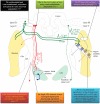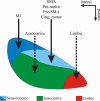The corticostriatal and corticosubthalamic pathways: two entries, one target. So what?
- PMID: 21866224
- PMCID: PMC3149683
- DOI: 10.3389/fnsys.2011.00064
The corticostriatal and corticosubthalamic pathways: two entries, one target. So what?
Abstract
The basal ganglia receive cortical inputs through two main stations - the striatum and the subthalamic nucleus (STN). The information flowing along the corticostriatal system is transmitted to the basal ganglia circuitry via the "direct and indirect" striatofugal pathways, while information that flows through the STN is transmitted along the so-called "hyperdirect" pathway. The functional significance of this dual entry system is not clear. Although the corticostriatal system has been thoroughly characterized anatomically and electrophysiologically, such is not the case for the corticosubthalamic system. In order to provide further insights into the intricacy of this complex anatomical organization, this review examines and compares the anatomical and functional organization of the corticostriatal and corticosubthalamic systems, and highlights some key issues that must be addressed to better understand the mechanisms by which these two neural systems may interact to regulate basal ganglia functions and dysfunctions.
Keywords: Parkinson's disease; basal ganglia; cerebral cortex; deep brain stimulation; hyperdirect; monkey; striatum; subthalamic nucleus.
Figures



References
LinkOut - more resources
Full Text Sources

